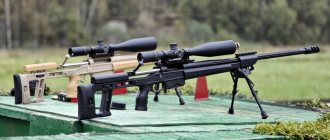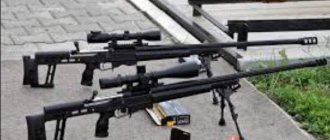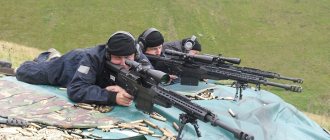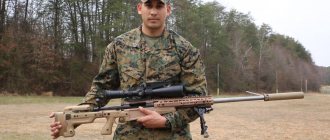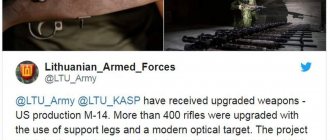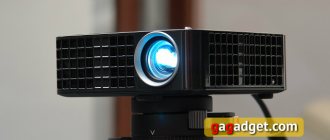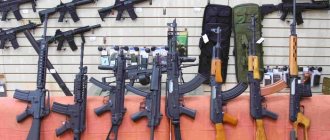04.06.2013
Sniper rifle MK12 MOD0/MOD1 (USA)
The Mk12 MOD Special Purpose Rifle, like its predecessor, the Mk12 MOD0 Special Purpose Rifle, belongs to the AR-15/M16 family of weapons. It is a 5.56×45 caliber automatic weapon using the principle of removing powder gases, used by the US Marine Corps in Afghanistan to engage targets at ranges up to 800 m. The rifles were originally developed to meet the needs of the Navy and Special Forces US Army in a new self-loading sniper and precision rifle. The history of the development of this weapon can be traced back to the Special Operations Peculiar Modification Kit program, abbreviated SOPMOD, developed in the 1990s.
SOPMOD kits were sets of components for retrofitting the M4A1 carbine, with the installation of which weapons, previously used only by special units, could be adapted for special operating conditions. When using retrofitting elements, aiming and target identification capabilities are improved, reaction time is reduced and shooting accuracy is improved, both in the close range and when using weapons at ranges of up to 600 m, day and night. The first SOPMOD kits were issued to the troops in 1995 and included the following components: ACOG-x4 sight, AN/PEQ-2A laser/light module, mounted 40-mm M203 grenade launcher, silencer, AN/PVS-17A night sight, handguard with four Picatinny rails according to military standard MIL-STD-1913.
As part of the development of the SOPMOD kit program, the Crane division of the US Navy Land Warfare Center began thinking about converting the M4A1 carbine into a sniper rifle by installing retrofitting units. Subsequently, these plans grew into an independent project, which led to the creation of the Mk12 MOD0 and Mk12 MOD1 special purpose rifles. In early 2003, the first Mk12 MOD1 SPR rifles entered service with the US Special Operations Command (SOCOM). in November of the same year, Mk12 MOD1 SPR rifles were issued to US Marine Corps units that participated in operations in Iraq and Afghanistan. Weapons for the United States Marine Corps are produced by the Precision Weapons Section of the training battalion located at the Marine Corps Base at Quantico, Virginia. In order to achieve the highest possible accuracy and keep manufacturing tolerances as low as possible, components only from specially certified manufacturers are used for the production of weapons.
The Mk12 MOD1 special purpose rifle, caliber 5.56×45, when unloaded, with a silencer, and a Leupold Mk.4 2.5-8×36 optical sight, weighs 5.5 kg, is 184 mm high and 82 mm wide. The length of the weapon without a silencer is 946 mm, with a silencer -1067 mm. The theoretical rate of fire without a silencer is from 625 to 650 rounds/min; with a silencer it rises to 775-800 rounds/min. Although the Mk12 MOD1 can also fire in short bursts and continuously fire, it should be mentioned that it was not designed for this.
The first Mk12 MOD1 trigger boxes were produced using those from the M16A1, while later production Mk12 MOD1s were based on the M4A1 design. They are equipped with match triggers, two-stage, with warning and a trigger force of 2 kg. manufactured by s Armament and has four military standard MIL-STD-1913 Picatinny rails, each 286 mm long. Along with other components, a front sling swivel for carrying a belt is installed on the bar.
The Mk12 MOD1 rifle has a long free-oscillating barrel with six right-hand rifling; rifling pitch - 7 inches (178 mm). The barrel length is 472.5 mm (18.6 in). The special shape of the barrel improves heat dissipation conditions and accuracy of fire while simultaneously reducing weight. Barrels for the Mk12 MOD1 are made by three different companies: Douglas Barrels Incorporated, Lewis Machine & Tool Company and Barrel Barn. Gas removal is carried out using a gas block mounted on the barrel, which is manufactured by the Crane division of the US Naval Land Warfare Center.
The Mk12 MOD1 SPR rifle uses the Leupold Mk4 2.5-8×36 MR/T M2 optical sight with Tactical Milling reticle. The aiming mark can be illuminated. The stable, waterproof sight weighs 454 g and has a length of 287 mm. The sight is optimized for use in twilight, and allows the shooter to clearly distinguish contours and targets even in low light. To eliminate glare, the sight has flip-up lens and eyepiece covers. The vertical and horizontal adjustment range is 90 arc minutes.
Adjustment is carried out with “clicks”; the price of a “click” is 1/4 arc minute. The sight is mounted to the Picatinny rail of the receiver using mounting rings from Atlantic Research Marketing Systems Incorporated. In case the optical sight is damaged, the Mk12 MOD1 SPR rifle also has a mechanical sight, which consists of a folding diopter rear sight and a folding front sight, also manufactured by s Armament mounting strip, on the lower Picatinny rail of the forend.
The Mk12 MOD1 SPR Special Purpose Rifle comes in a waterproof, dustproof, shockproof Pelican 1700 weapon case. It is made from black, extremely impact-resistant polypropylene copolymer. The case weighs 7.7 kg, has a length of 968 mm, a width of 406 mm and a height of 155 mm; internal dimensions are 908 mm in length, 343 mm in width and 133 mm in height. Rifle cleaning supplies are available from Otis Technology Incorporated; It comes in a convenient nylon bag with a zipper.
Along with other components, the cleaning kit includes a Memory-Flex cleaning cord, a rag holder, and a variety of barrel cleaning brushes. Additionally, a nylon coated cleaning rod and cleaning rod guide are included with the rifle for intensive cleaning. The documents that are supplied to the troops along with the rifle include the “Operating Manual for the 5.56 mm Special Purpose Rifle Mk12 MOD1 TM11416A-OR-1,” which describes in detail the maintenance and handling of the rifle. It is provided in both printed and electronic form on CD-ROM. in pdf format. The form documents the accuracy of fire. The scope comes with an instruction and maintenance manual, as well as a description of the Tactical Milling reticle. The Mildot Master counting ruler is very useful, with the help of which, using the data obtained from the reticle. you can quickly and easily determine the distance to the target and the drop of the bullet relative to the throwing line. A table with ballistic data is equally useful.
The Mk12 MOD1 Special Purpose Rifle can fire all 5.56x45 caliber cartridges accepted by the US military. Especially for use with this rifle, cartridges with a special 77-grain (5 g) bullet for shooting at long distances Mk2b2 MOD0/MOD1 AA53 (77 gr Long Range Special Ball Mk262 MOD0/MODl AA53) are issued. These cartridges use a 77-grain match bullet with a hollow point and tapered tang (CRVT). The Mk262 MOD0 cartridges are produced using Sierra Matchking bullets from Black Hills Ammunition. The Mk262 MOD1 cartridge uses Sierra Matchking bullets from both Nosier Incorporated and Black Hills Ammunition. The National Defense Industrial Association (ND1A) claims the accuracy of these rounds to be less than 1 arc minute. When firing these cartridges from an M16A4 assault rifle or an M4A1 carbine, they achieve an accuracy of 2 arc minutes; standard US Army M855 infantry cartridges achieve accuracy of only 3 to 5 arc minutes. According to the Service Manual, when using Mk262 MODO/MOD1 AA53 cartridges, the Mk12 MOD1 SPR rifle can confidently hit head targets up to a distance of 600 m and height targets up to 800 m. According to official reports, snipers of special forces of the US Armed Forces, as well as marksmen of the Marine Corps with their Mk12 MOD1 SPR rifles in Afghanistan they consistently neutralize targets at ranges over 700 m.
Source
Number of impressions: 3168
See also on Spetsnaz.org:
- Taurus - pistols and shotguns at the IWA exhibition
- AGS-40 "Balkan": a destructive beast in a new guise
- Killer "Baby", Izhevsk "Baghira" and "Varyag": a powerful trio for special forces
- Hello Karl! Let's get to know each other better?
- “Smart ammunition”: Russian grenade launchers will tear apart any American armor
Sniper rifle Steyr-Mannlicher SSG 69 (Austria)
The SSG 69 rifle was developed and manufactured by the Austrian company Steyr-Daimler-Puch (currently Steyr-Mannlicher AG). In 1969, it was adopted by the Austrian Army, hence its name (ScharfSchützen-Gewehr 69 - sniper rifle model 1969). The Steyr-Mannlicher SSG 69 sniper rifle was produced in 4 modifications - SSG-PI, SSG-PII, SSG-PIIK and SSG-PIV. The SSG-PI variant (aka SSG 69) was originally designed as a military sniper rifle, having both conventional sights (front and rear sights) and optical sight mounts, and has a 660mm barrel. The SSG-PII was created for the police, has a heavy barrel of the same length and does not have conventional sights. SSG-PIIK has a shorter (508mm) barrel length, which, however, does not affect accuracy at distances up to 500 meters. SSG-PIV is known as SSG SD in Europe. It has an even shorter barrel (406mm), threaded for installing a flame arrester or silencer.
The Steyr-Mannlicher SSG 69 sniper rifle is a manually loaded repeating rifle. The bolt is longitudinally sliding, rotating, locking is carried out by 6 radial protrusions in the rear part of the bolt through grooves in the receiver. The barrel is heavy, made by cold rotational forging. The trigger mechanism is adjustable. descent with warning. Rotary magazine for 5 rounds, detachable. At one time, box magazines with a capacity of 10 rounds were also produced, but their production was discontinued. The stock is made of plastic (SSG 69 was the first sniper rifle to have such a stock), the length of the butt can be adjusted using special rubber gaskets under the butt plate. In addition to seats for installing optical sights, the SSG 69 in the military is equipped with open, adjustable sights; the police versions do not have open sights.
RPA sniper rifle (UK)
A small British company, RPA International Ltd, began its business 40 years ago with the production of components for high-end sporting rifles, and then moved on to the production of match rifles of the original design. The rifles of this company have been successfully and repeatedly used in world-class competitions, and in 2001 the company introduced the first “police” type sniper rifle chambered for 7.62x51 NATO, created on the basis of its match rifles, which received the designation RPA “Rangemaster”. In 2004, a shortened modification of the same caliber appeared for use in the city, at short ranges, as well as the RPA “Rangemaster” long-range rifle in .338 Lapua Magnum caliber, which is a slightly enlarged version of the 7.62mm caliber rifle. Currently, the RPA "Rangemaster" series rifles are in service with a number of police units and security services in several European countries, and they are also supplied to other regions of the world. When using the correct ammunition, the company claims accuracy of less than one minute of arc (1 MOA) for its rifles at all practical firing ranges.
The RPA "Rangemaster" sniper rifle uses manual reloading with a longitudinally sliding rotary bolt having four radial lugs in the front. The receiver is steel, of original design. The trigger mechanism is adjustable, release with warning (two-stage). The rifle's stock is composite, with a folding stock of an original design, allowing, if absolutely necessary, to shoot with the stock folded. The cartridges are fed from detachable box magazines. The rifle is standardly equipped with a folding bipod and an adjustable rear support in the butt. Sights (day or night optical sights) are mounted on a Picatinny rail on the receiver; the rifles do not have open sights.
Sniper rifle Accuracy International L96 A1 / Arctic Warfare (UK)
In the early 1980s, the British Army announced a competition to replace its aging Enfield L42 sniper rifles. The main participants in the competition were the English companies Parker-Hale with the Model 82 rifle, and Accuracy International with the Model RM rifle.
The RM rifle emerged victorious in this competition, and in the mid-1980s it was adopted by the British Army under the designation L96. The main distinguishing feature of this rifle was the stock of an unusual type and design: the basis of the stock is an aluminum beam running along the entire length of the stock, to which the barrel with receiver, trigger mechanism and all other parts of the rifle are attached, including the stock itself, consisting of 2 plastic half - left and right. In addition, L96 rifles are equipped with open sights in addition to the mandatory optical sight.
In the mid-1980s, the Swedish Army also began searching for a new sniper rifle suitable for use in harsh northern weather conditions. Accuracy International offers the Swedes a modified version of the L96 rifle called the Arctic Warfare, and in 1988 the Swedish Army adopted it under the designation PSG.90. The British Army, in turn, is also adopting Arctic Warfare rifles (new designation L96A1).
The main model of the series, the AW, is designed as an army weapon; in addition to it, four more basic models are produced: Police (AWP), Suppressed (AWS), Folding (AWF) and Super Magnum (AW SM). The name of the series (Arctic Warfare = Arctic combat) comes from the fact that the rifles have special design features that allow them to be used in Arctic conditions (at temperatures down to -40 degrees Celsius). The AW, AWP and AWS models are chambered only in 7.62mmNATO, while the SM model is chambered in .338 Lapua Magnum, .300 Winchester Magnum and 7mm Remington Magnum. The barrel of the AW model has a length of 660mm, the AWP model - 609mm. AW SM model barrels can have a length from 609mm to 686mm. The AWS model is equipped for use with suppressor and subsonic ammunition. The accuracy of the basic AW model is such that at a distance of 550 meters a series of 5 shots fits into a circle less than 50mm in diameter! The rifles are equipped with Smidt&Bender 3-12X variable magnification scopes or Leupold Mark 4 constant 10X magnification scopes, as well as a folding removable bipod.
Sniper rifle Steyr-Mannlicher SSG 08 (Austria)
The SSG 08 sniper rifle, introduced in 2008 by the famous Austrian company Steyr-Mannlicher AG, is a further development of their fairly successful SSG 04 sniper rifle. The new SSG08 rifle was created with the participation of experts from the famous Austrian police special forces unit COBRA, and differs from its predecessor mainly a new aluminum stock with a side-folding adjustable butt, and, as a result, slightly greater weight.
The Steyr-Mannlicher SSG 08 sniper rifle has a longitudinally sliding rotary bolt with four lugs located in pairs in front of the bolt. High-precision barrels are made using cold rotational forging and are equipped with a muzzle brake. The trigger mechanism is adjustable, release without warning. The cartridges are fed from detachable box magazines. The rifle stock is made of aluminum with plastic linings and has a side-folding buttstock with a height-adjustable comb and butt plate. An adjustable rear support is built into the butt, and there is a mount for a folding bipod in the front of the stock. The rifle does not have open sights; a Picatinny rail type guide is installed on the receiver, allowing for quick and accurate installation of any optical and night sights on the appropriate mounts. Additional Picatinny rail type guides are installed on the forend and are intended for attaching accessories (for example, a laser laser).
